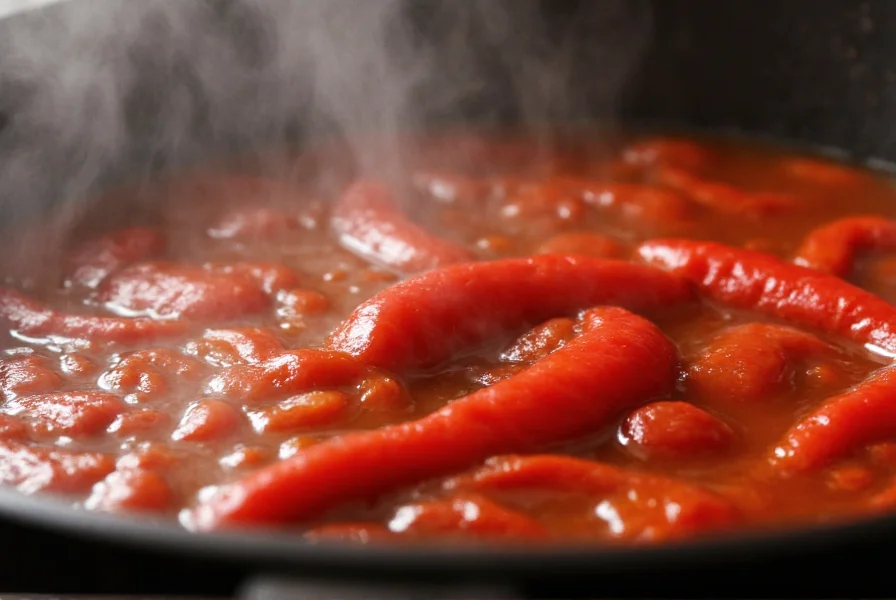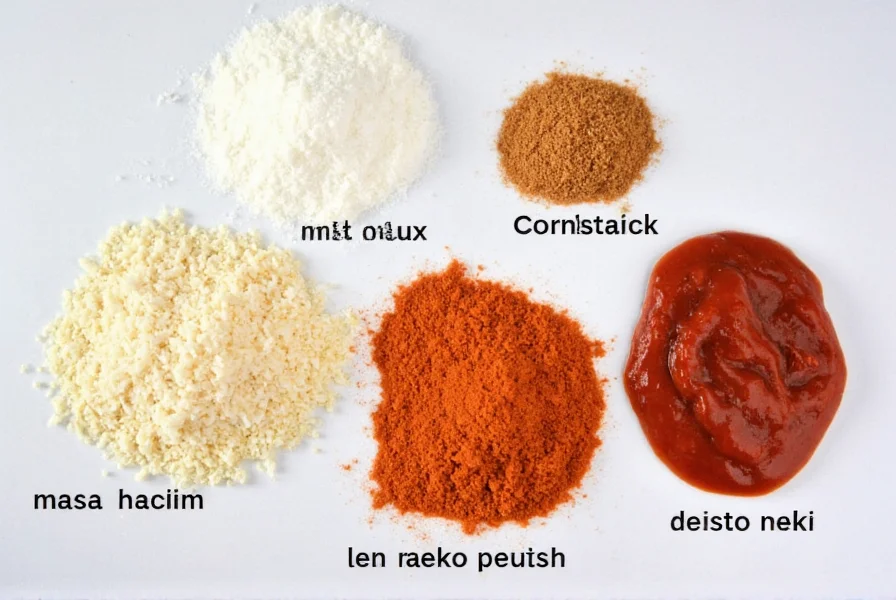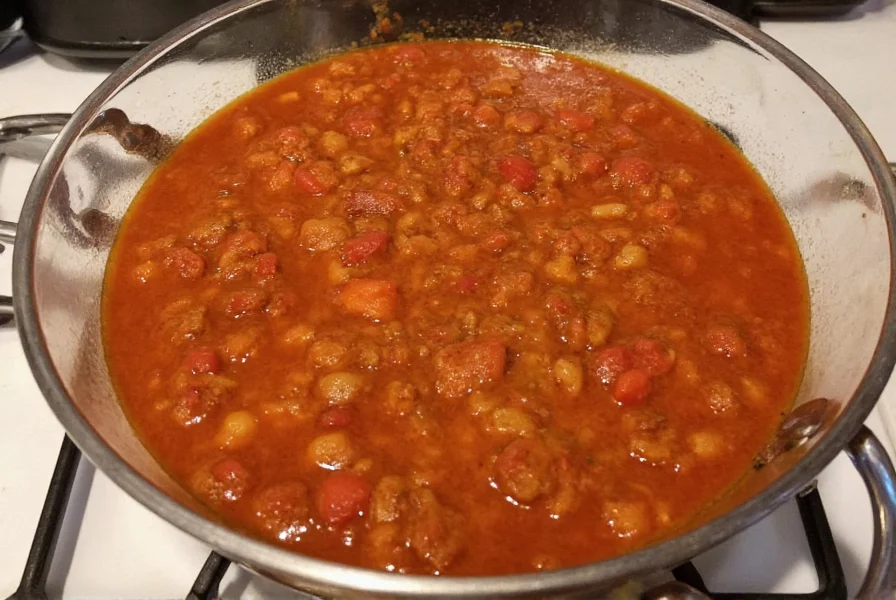Chili that's too thin can ruin an otherwise perfect meal, but fixing it is simpler than most home cooks realize. Whether you're in the middle of cooking or have leftovers that didn't set properly, multiple effective thickening methods exist that won't compromise your chili's flavor profile. Understanding why your chili turned out watery in the first place—often due to excess liquid from tomatoes, beans, or meat—is the first step toward correcting it.
| Thickening Method | Time Required | Flavor Impact | Best For |
|---|---|---|---|
| Simmer Uncovered | 15-30 minutes | None | All chili types |
| Cornstarch Slurry | 5 minutes | Minimal | Quick fixes |
| Mashed Beans | 10 minutes | Slight bean enhancement | Bean-based chili |
| Tomato Paste | 5 minutes | Richer tomato flavor | Tomato-heavy recipes |
| Masa Harina | 5 minutes | Subtle corn flavor | Authentic chili recipes |
Simmering Uncovered: The Natural Reduction Method
One of the best ways to thicken chili without flour involves simply simmering your pot uncovered. As the chili bubbles gently, excess moisture evaporates while flavors concentrate. This method preserves your chili's original taste profile while improving texture. For optimal results, maintain a low simmer—boiling too vigorously can cause scorching on the bottom. Stir occasionally to prevent sticking, and check consistency every 5-7 minutes. Most chili recipes require 15-30 minutes of uncovered simmering to reach ideal thickness. This approach works exceptionally well for how to make chili thicker naturally without introducing additional ingredients.

Cornstarch Slurry: Quick Thickening Without Lumps
When you need to fix watery chili quickly before serving, a cornstarch slurry provides immediate results. Combine one tablespoon of cornstarch with two tablespoons of cold water for each cup of chili you're thickening. Whisk thoroughly until completely smooth—this prevents the common problem of lumps forming. Slowly drizzle the mixture into your simmering chili while stirring constantly. Within 2-3 minutes, you'll notice significant thickening. This method works particularly well for thickening agents for chili recipe that can't tolerate additional cooking time. Remember that cornstarch loses effectiveness if boiled too long, so remove from heat once desired consistency is reached.
Bean Mash Technique: Flavor-Enhancing Thickening
For bean-based chili recipes, the how to thicken chili without changing flavor challenge has a perfect solution. Remove approximately one cup of chili (including beans) and mash thoroughly with a fork or potato masher. Return this thickened mixture to the main pot and stir well. The released starches from the beans act as natural thickeners while maintaining the dish's integrity. This technique works especially well with kidney beans or pinto beans, which contain ample starch. It's an excellent approach for those seeking natural thickeners for homemade chili that actually enhance rather than mask existing flavors.
Tomato Paste and Masa Harina: Flavorful Alternatives
Tomato paste serves dual purposes when thickening chili too thin what to add dilemmas arise. Not only does it absorb excess liquid, but it also intensifies tomato flavors already present in most recipes. Start with one tablespoon per quart of chili, stirring well and allowing five minutes for absorption before adding more. For authentic Southwestern flavor, masa harina (corn flour treated with lime) makes an exceptional thickener. Unlike regular flour, it blends smoothly and adds a subtle corn flavor that complements traditional chili spices. Use one tablespoon of masa harina mixed with two tablespoons of cold water per quart of chili for perfect results.

Preventing Thin Chili: Proactive Measures
Avoiding the need for how to fix watery chili quickly starts with proper ingredient ratios. When building your chili base, consider these preventative measures:
- Drain canned beans thoroughly before adding
- Use crushed tomatoes instead of tomato sauce for less liquid
- Brown meat properly to render excess fat and moisture
- Add liquids gradually rather than all at once
- Include thickening ingredients from the start (like masa harina)
Understanding your recipe's liquid-to-solid ratio prevents most thinning issues before they occur. Most successful chili recipes maintain approximately 60% solid ingredients to 40% liquid—a balance that yields hearty texture without requiring last-minute corrections.
Troubleshooting Over-Thickened Chili
If your thickening efforts go too far, don't panic. Gradually add small amounts of broth, beer, or even water while heating gently. For flavor balance issues caused by thickening agents, consider these fixes:
- Excess cornstarch taste? Simmer with a pinch of cumin
- Too much masa flavor? Add a splash of vinegar
- Overly concentrated spices? Stir in a spoonful of honey
Remember that chili often thickens further upon cooling, so aim for slightly thinner consistency than desired when serving immediately.
Frequently Asked Questions
Can I use flour to thicken chili?
While flour can thicken chili, it's not recommended as it often creates lumps and requires careful cooking to eliminate raw flour taste. If using flour, make a roux first by cooking equal parts flour and fat for 2-3 minutes before adding to chili. Cornstarch or masa harina provide smoother results for thickening agents for chili recipe.
How long does it take to thicken chili by simmering?
Simmering uncovered typically takes 15-30 minutes to noticeably thicken chili, depending on initial liquid content and heat level. Check consistency every 5-7 minutes and stir occasionally to prevent sticking. This natural method for how to make chili thicker naturally works best at a gentle simmer rather than a rolling boil.
Will adding more meat thicken chili?
Adding more meat alone won't significantly thicken chili, though properly browned meat does absorb some liquid. For effective thickening, focus on methods like reducing liquid through simmering, using starches, or incorporating mashed beans. The best way to thicken chili without flour involves techniques that target the liquid component directly.
Can I thicken chili in a slow cooker?
Yes, but slow cookers present challenges for thickening since they maintain consistent moisture. To thicken chili in a slow cooker, remove the lid during the last hour of cooking to allow evaporation. You can also mix in a cornstarch slurry during the final 30 minutes. This approach works well for how to fix watery chili quickly even in slow cooking environments.
Does cooling thicken chili?
Yes, chili naturally thickens as it cools due to starches and proteins setting. Many chili recipes actually recommend making them a day ahead for this reason. If your chili seems too thin when hot, try refrigerating overnight—reheating the next day often yields perfect consistency. This is why understanding how to thicken chili without changing flavor is crucial for proper initial preparation.











 浙公网安备
33010002000092号
浙公网安备
33010002000092号 浙B2-20120091-4
浙B2-20120091-4